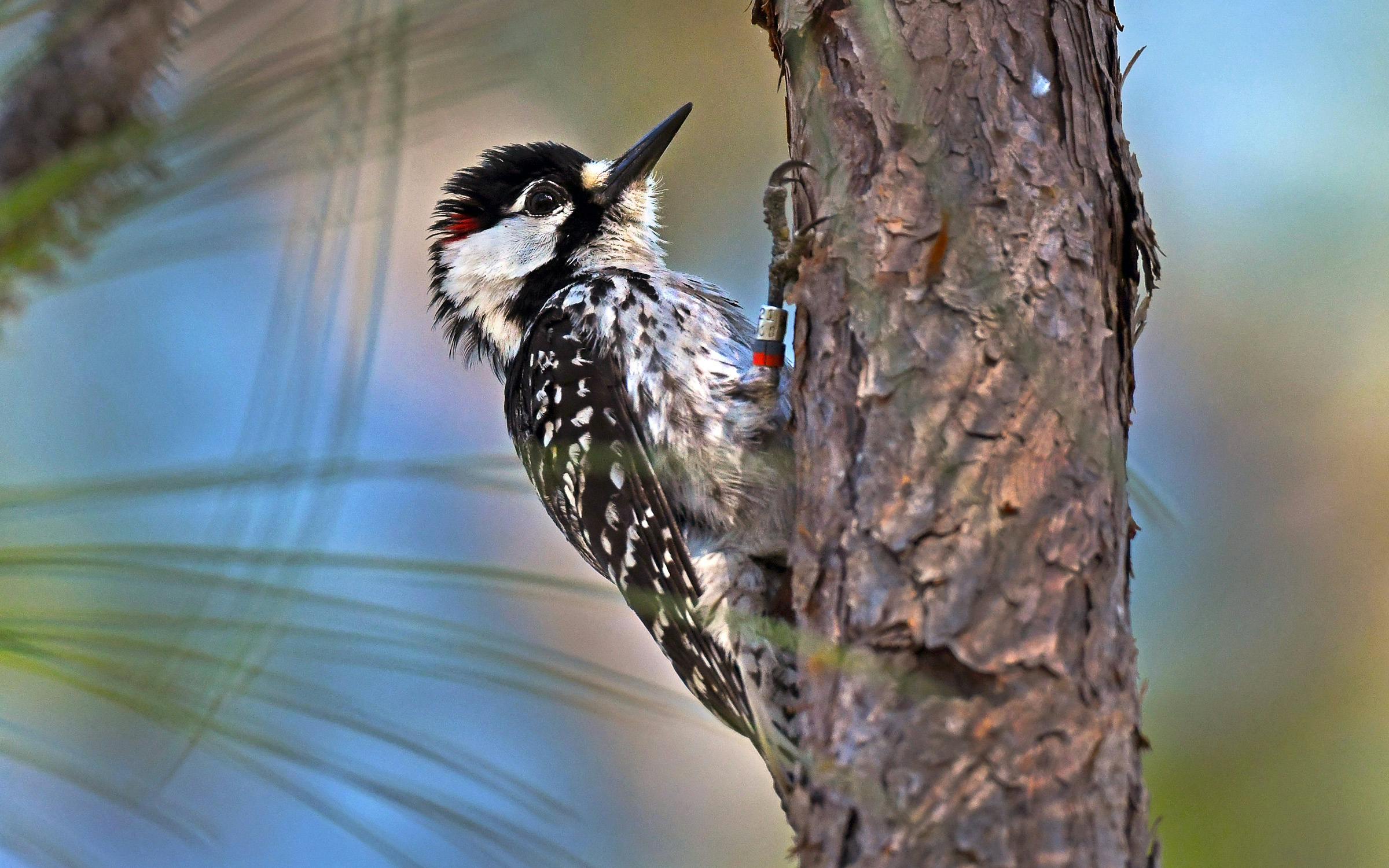The red-cockaded woodpecker is an unusual bird. An eight- or nine-inch ball of black and white feathers, it’s found in East Texas forests with an open understory, carving its nest cavities in living pine trees and drilling little holes around the openings, which drip sticky sap to deter predators, such as rat snakes. The males have a tiny, nearly invisible red streak, or cockade, on the upper border of the cheek. Unlike most woodpeckers, mated pairs of this species don’t raise their offspring alone. “Typically, the young of the previous year, most often the males, will stick around for a few years and help their parents raise their younger siblings,” says Tania Homayoun, an ornithologist with Texas Parks and Wildlife. “They’ll stick fairly close to the family colony site and then take over the site themselves when the mated pair eventually passes on.”
Red-cockaded woodpeckers were once common throughout the forests of the southeastern United States, from New Jersey to Florida, with the Piney Woods of East Texas representing the westward limit of their range. By the 1970s, however, a mixture of development, changing agricultural practices, and habitat loss landed them on the endangered species list. But on October 24, the U.S. Fish and Wildlife Service announced that the woodpecker’s numbers—buoyed by fifty years of conservation efforts from a constellation of government authorities, private businesses, and landowners—have recovered enough to warrant downgrading it from endangered to threatened status. However, the bird isn’t out of the woods yet—and not everyone’s happy about the decision.
Red-cockaded woodpeckers have extremely specific criteria when it comes to real estate, Homayoun said. It’s not just their preference for establishing their family colonies in living trees rather than the snags (dead and dying trees) that other woodpeckers use. They also need large, old-growth pine trees—ideally sixty to eighty years old or older—and forests where the understory is made up of shaded grass, not dense thickets of shrubs. In places where the timber industry has harvested old trees or where land managers have chosen not to set regular fires to clear out understory brush, the woodpeckers disappear. After a century of heavy logging across the region (and a misplaced zeal for fire suppression on the part of land managers), the birds found their habitat chewed away. By the late 1970s, the species’ population had plummeted to a mere 1,470 colonies. In Texas a range that had once included 41 counties has dropped to only twelve.
The Endangered Species Act provided a lifeline. According to the U.S. Fish and Wildlife Service announcement, voluntary safe-harbor agreements with landowners in several states brought around 2.5 million acres of protected land into the birds’ range. Timber companies and private landowners also agreed to increase controlled burns to create the open and grassy longleaf pine forest habitats that the woodpeckers need. That, plus more targeted management by state and federal agencies, which included translocating birds to establish new populations and the use of artificial cavities for the birds to nest in, led to an impressive comeback. There are now roughly 7,800 colonies across the bird’s range.
“The downlisting of the red-cockaded woodpecker marks a significant milestone in our nation’s commitment to preserving biodiversity,” Secretary of the Interior Deb Haaland said in a statement. “This is another important accomplishment in the U.S. Fish and Wildlife Service’s implementation of the iconic Endangered Species Act.”
But there’s a significant difference between being taken off the Endangered Species List and being safe. Red-cockaded woodpeckers are still threatened by habitat loss and the splintering of their range, and still will receive some conservation protection. Some nature advocacy organizations, however, including Defenders of Wildlife, believe that even bumping the bird down to threatened status is premature. In 2021 Defenders and the Southern Environmental Law Center argued against the proposal, citing the threat of increasingly severe storms caused by global warming. The final decision came about a month after Hurricane Helene—one of the largest and most destructive storms to hit the species’ eastern range in recorded history. This timing only underscores the point, Ben Prater, Southeast program director for Defenders of Wildlife, wrote in a statement following the announcement. “Decades of significant progress have been made to recover this species and manage habitats effectively—progress which could now be upended at a critical time,” he added.
Texas Parks and Wildlife hasn’t yet offered a formal public statement on the federal decision. But in a formal comment the agency made on the proposal, it noted that given the need for intensive conservation to keep the woodpeckers alive, “delisting the red-cockaded woodpecker would be premature and may result in further decline of the species,” potentially including its disappearance from Texas.
One bright spot: Most of the Texas birds are on protected land. Approximately 90 percent of red-cockaded woodpeckers in the state live on land managed by the U.S. Forest Service, as the Texas Parks and Wildlife letter noted, particularly the Davy Crockett, Sam Houston, Angeline, and Sabine national forests. There, at least, the pine trees still grow tall, the controlled fires still keep the thickets at bay, and generations of woodpeckers raise their young (and their siblings) in sap-drenched holes.

